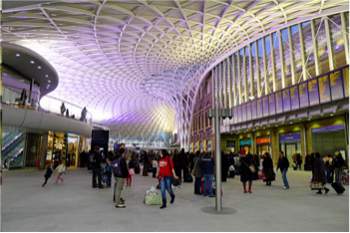Government funding of the rail industry fell by £400m in 2014-15, with income from passenger fares rising by the same amount, according to new figures.
During the last financial year the industry had overall income of £13.5bn, of which 71% came from passengers and 26% from various government sources, according to industry regulator the Office of Rail and Road (ORR). Other sources of income, such as property, contributed 3%.
The ORR said its analysis shows that this is the first year payments from franchised train operators to the Treasury exceeded net support from government. It attributes this mainly to a change from government supporting train operators, to increased support for Network Rail.
The figures reflect a continuing trend of rising passenger contribution to the cost of the rail network.

Kings Cross station in London
Government funding of the industry stood at £3.5bn, down 9%. This includes funding from all government sources, including devolved administrations and passenger transport executives.
After adjusting for the finance costs paid by Network Rail to the Department for Transport, government funding to the rail industry has fallen by 14%, to £3.1bn.
Stephen Joseph, chief executive of Campaign for Better Transport said: ‘Rail users are continuing to pay record amounts toward the running the railways. With ticket sales now representing nearly three quarters of total income, passengers interests like simpler, cheaper, fairer ticketing and better stations and trains should be central to rail policy rather than languishing at the margins.’
The ORR said a 5% increase in income from passengers, to £8.8bn, is primarily because of a 4% rise in passenger journeys, as well as fare increases of 1% in real terms.
Most of the increase in journeys has been in London and the South East. Unregulated fares accounted for 62% of total fare income, with the rest from regulated fares.
The overall cost of running Britain’s railways was £13.6 bn, of which 54% was incurred on train operations and 46% on infrastructure.
Net funding from government for rail infrastructure rose by 12% from £3.7bn to £4.2bn. The ORR says a £0.9 billion (7%) rise in industry costs was ‘largely due to an increase in Network Rail’s maintenance and renewals costs, as well as an increase in train operator costs’.
Total government funding varied from £1.66 per passenger journey in England to £6.70 per journey in Scotland and £9.14 per journey in Wales. The ORR said these differences are partly due to very different average passenger densities, with high fixed costs.
ORR chief executive Joanna Whittington said: 'Railway use continues to rise and as passengers are a significant source of funding for the industry, they must lie at the heart of the railways’ continued evolution. Our industry financials publications provide an open and comprehensive explanation of industry income and expenditure to help passengers understand how the money they pay in fares is being used.'
Register now for full access
Register just once to get unrestricted, real-time coverage of the issues and challenges facing UK transport and highways engineers.
Full website content includes the latest news, exclusive commentary from leading industry figures and detailed topical analysis of the highways, transportation, environment and place-shaping sectors.
Use the link below to register your details for full, free access.
Already a registered? Login